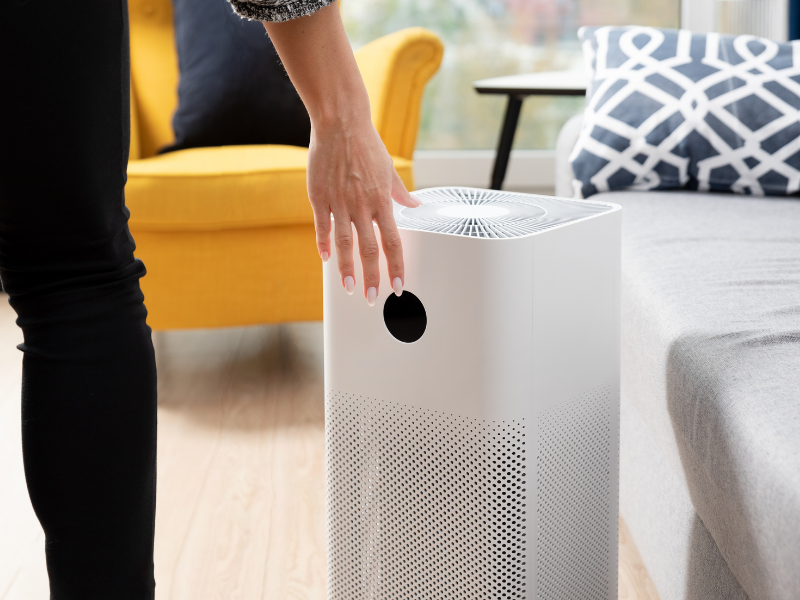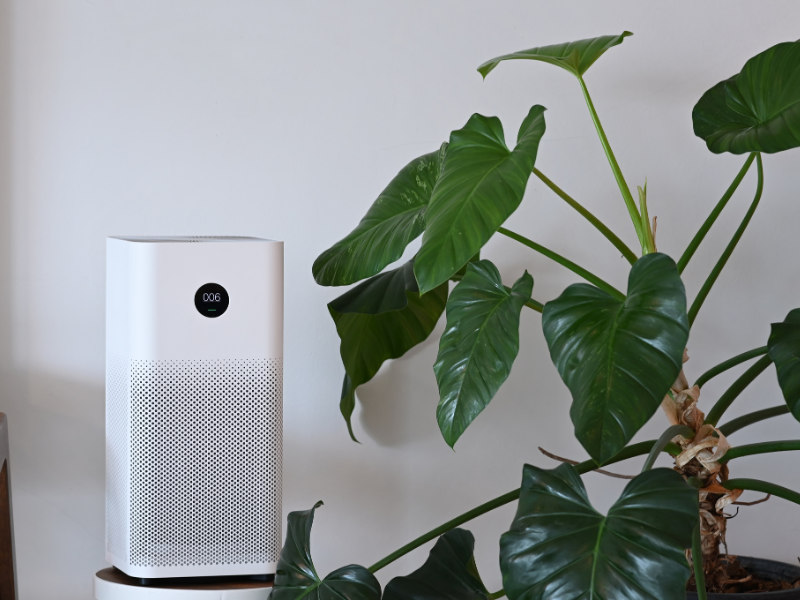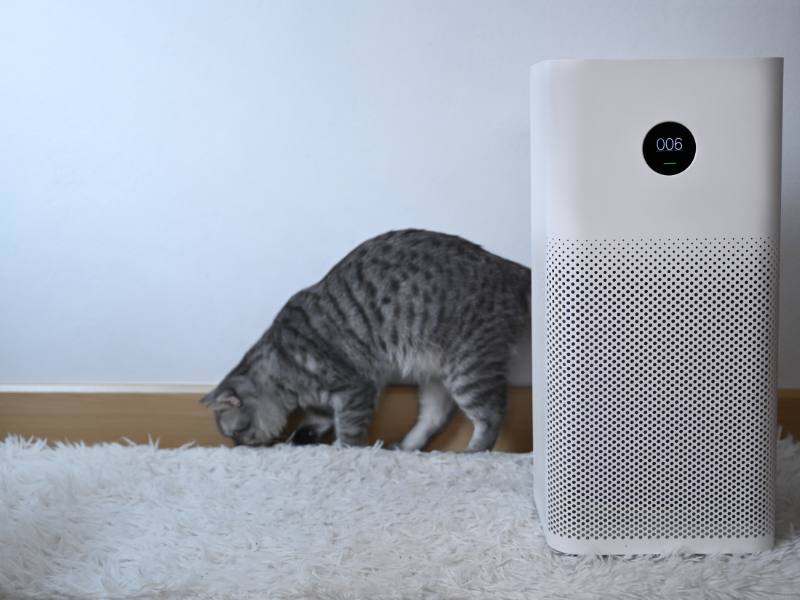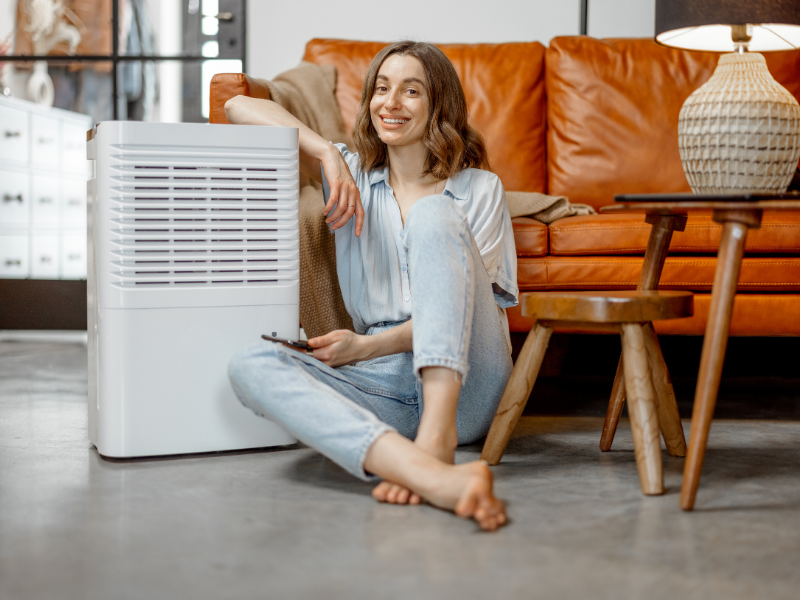When air purifiers for the home were first introduced in the 1960s and ’70s, they were very basic appliances that needed to be switched on and off manually. By contrast, today’s models are sophisticated machines designed with the modern homeowner in mind and offer a variety of features.
Need an air purifier that adjusts its fan speed automatically to help you save money on your electric bill? Or one that can be controlled using your mobile device? Maybe one that reminds you when it’s time to change the filter? There are some air purifiers that can do all of these and more.
The only problem is too many bells and whistles can be overwhelming, and you may find many of them are unnecessary. Or perhaps you don’t know which ones are the most important.
That’s why SaysHome is here to help. I’m cutting through the marketing gimmicks and listing the top features to look for when choosing an air purifier for your home.
Contents
- 1 How to Choose the Right Air Purifier
- 2 Improve Your Indoor Air Quality: Overview of the 10 Most Common Air Purifier Features
- 3 This Way to Fresh Air: Air Purifier Features in Greater Detail
- 3.1 1. HEPA Filters
- 3.1.1 Medical Grade Air Purifiers
- 3.1.2 A Superhero Indoor Air Cleansing Duo: Activated Carbon Filters and HEPA Filters
- 3.1.3 How to Verify An Air Purifier Uses a Genuine HEPA Filter
- 3.1.4 HEPA for the Win: HEPA Filters Versus Ionic Filters That Produce Ozone
- 3.1.5 What About UV Lights?
- 3.1.6 Nothing Lasts Forever: Plan For Replacement Filters
- 3.2 2. CADR (Clean Air Delivery Rate) Rating
- 3.3 3. Noise Level/Sleep Mode
- 3.4 4. Air Quality Sensors/Auto Mode
- 3.5 5. Portability
- 3.6 6. Smart/WiFi Connectivity
- 3.7 7. Child Lock
- 3.8 8. Timer
- 3.9 9. Filter Replacement Reminder
- 3.10 10. Remote Control
- 3.1 1. HEPA Filters
- 4 Top Five Air Purifiers with Essential Features
- 5 Knowing Air Purifier Features Make Buying One Easier
- 6 Author
While the best air purifier features to have depended solely upon your particular needs and budget, I’ll break down what is considered the most important ones to ensure your air purifier is actually doing its job and cleansing the air. My list also includes some “nice to have” features that may or may not be deal breakers for you.
From filter types to noise level, this list will help you determine which air purifier features you need to deliver the most bang for your buck!
How to Choose the Right Air Purifier
Purchasing an air purifier can be one of the best investments you make for your home. Air purifiers remove all kinds of airborne particles and impurities, making the air inside your home easier to breathe for you and your family which can reduce allergic reactions.
But before you know what features you need in an air purifier, you’ll have to ask yourself a few questions first.
Why, exactly, are you interested in buying an air purifier? Do you have a smoker in the household or do you live in an area that sees a lot of wildfire smoke?
Do you have allergies? Do you have pets? Do you plan on running the air purifier while you sleep?
Do you like a set-it-and-forget-it model or would you prefer one that automatically adjusts as the air quality changes? What about one that connects to your mobile device, so you can track air quality even when you’re not home?
Lastly, what is the room size where you will be running the air purifier, and what kind of budget do you have in mind?
Taking the time to think about the reasons why you want an air purifier can help you narrow down which features will be most useful to you.
Improve Your Indoor Air Quality: Overview of the 10 Most Common Air Purifier Features
Doing a simple search for “air purifier” on Amazon pulls up an astounding 20 pages of results. But one thing you’d notice if you browse through them is that many of these air purifiers share many of the same features designed with convenience and effectiveness in mind.
Here’s a quick list and brief description of the ten most common air purifier features and characteristics you’re likely to come across when searching for an air purifier that best fits your needs. Don’t worry, I’ll explore each of these in greater detail.
I’ve listed these in general order of those that are the most important features to ones that can be nice perks but aren’t necessary to keep your air clean.
- HEPA Filter – the filter system is at the heart of every air purifier because without it, it can’t cleanse the air properly. The gold standard for most consumer air purifiers is the HEPA (“high-efficiency particulate air filter”) which is capable of filtering out over 99% of the most common home air pollutants including dust, pollen, and pet dander. Most air purifiers use a HEPA, and experts widely consider it to be the most effective filtration method.
- Clean Air Delivery Rate (CADR) – not so much a feature as a rating, but it’s something you’ll want to note to ensure an air purifier’s power matches the room you want to use it in.
- Noise Level – when it comes to air purifiers, the quieter, the better. Some air purifiers offer a silent or sleep mode so that operating the unit won’t disrupt sleep or make watching TV or having a conversation in the room difficult.
- Air Quality Sensors/Auto Mode – some air purifiers are designed so that they can sense the air quality in a room and automatically adjust their fan speed, helping to keep your electric bill under control.
- Portability – some air purifiers are lighter and easier to transport than others, and this may be important to you if you plan on using yours in several rooms and have stairs in your home.
- Smart/Wifi Connectivity – being able to connect your air purifier to an app on your mobile device can enable you to program it to operate at specific times and deliver data on the air quality of your room.
- Child Lock – a nice feature to have to prevent the little ones from messing around with your air purifier setting.
- Timer – a built-in timer can come in handy to set the air purifier to run for preset increments.
- Filter Replacement Reminder – a reminder when it’s time to change the HEPA filter.
- Remote Control – if mobile app connectivity is not your thing, a remote control can help you operate your air purifier without

This Way to Fresh Air: Air Purifier Features in Greater Detail
As you can see, today’s air purifiers are sophisticated appliances that offer more than a way to keep your home’s air clean. Below, I describe each feature in greater detail and why you may want to consider buying an air purifier that offers it.
1. HEPA Filters
If I had to pick one “must have” feature you should look for in an air purifier, without question that would be a HEPA filter.
Virtually air purifiers sold today use a standard HEPA filter to clean the air so this isn’t a difficult feature at all to find. However, you may occasionally encounter an air purifier that relies on a less effective filter system, so it’s good to know why a HEPA filter is so important (and safer) to have.
HEPA stands for “high efficiency particulate air (filter)” as defined by the U.S. Department of Energy. Fun fact: the HEPA filter was actually developed during The Manhattan Project as a way to filter out harmful radioactive particles in the air while the atomic bomb was being developed. So if it was good enough for a group of genius physicists, it’s good enough for you, too.
It is considered the best kind of filter for an air purifier because it is capable of filtering out 99.97% of extremely tiny airborne pollutants that are 0.3 microns in size. The list of airborne pollutants that a HEPA filter can catch include:
- Dust
- Dust mites
- Pollen
- Pet Hair and Pet Dander
- Smoke (cigarette smoke as well as wildfire smoke)
- Mold Spores
- Bacteria
- Viruses
That’s a pretty extensive list, which is why this type of filter has been widely adopted by air purifier (and vacuum cleaner) manufacturers. To give you an idea of size comparisons, pollen and mold tend to be on the larger size, usually falling anywhere between 10 and 100 microns. Dust particles and dust mites are about 10 microns or less. Smoke is even smaller, at around 1 micron. Technically, viruses and bacteria are smaller than 0.3 microns in size but because they are usually suspended in liquid droplets called aerosols, HEPA filters can trap them.
Medical Grade Air Purifiers
Medical grade air purifiers are designed to capture particles as small as 0.1 microns, but many of them are too bulky, heavy, and expensive for the average consumer and their needs. However, if you have members in your household with immunity or health concerns, this type of air purifier may be worth looking into. Look for an air purifier that says it has an H13 HEPA filter, which is medical grade level.
The HEPA filter itself is pleated, like an accordion, and made of plastic or borosilicate glass fibers. These fibers contain narrow passageways for air to pass through but trap pollutants in the process. Air purifiers use a fan to pull air through the filter. The air passes through the HEPA filter which collects the pollutants, resulting in clean air blowing out from the unit.
A Superhero Indoor Air Cleansing Duo: Activated Carbon Filters and HEPA Filters
It’s important to note that HEPA filters are usually part of a multi layer filter system found in most air purifiers, because as great as they sound, they actually cannot filter out gases and volatile organic compounds, also known as VOCs. That’s because these particles are so small they can pass through the HEPA fibers.
For these kinds of air contaminants, you need an activated carbon filter which is often included as a pre-filter and helps trap the smallest pollutants. Fortunately, just about every air purifier that uses a HEPA also uses a carbon filter to help trap gaseous pollutants.
How to Verify An Air Purifier Uses a Genuine HEPA Filter
When choosing an air purifier, always buy one that states it uses a “true HEPA filter” to cleanse the air. While the term has no legal meaning, it should mean the product contains an actual HEPA filter system as opposed to air purifier manufacturers that market their products as “HEPA-like”, “HEPA-style” or “99% HEPA”. These don’t meet HEPA standards and they may not have undergone independent testing.
HEPA for the Win: HEPA Filters Versus Ionic Filters That Produce Ozone
Some air purifiers rely on an ionizer rather than a HEPA filter to “purify” the air. These products are usually referred to as ionizers or ionizer air purifiers meaning instead of blowing air through a filter system, they produce negatively charged ions that attach themselves to contaminants floating in the air. This causes them to plummet to the floor and other surfaces in a room where you can vacuum or dust them up.
While ionizers don’t require you to purchase replacement filters, they have many drawbacks. For starters, the Environmental Protection Agency considers them to be ozone generators which can do more harm than good to some individuals. Ozone is considered a lung irritant and can aggravate asthma and bronchitis, as well as cause shortness of breath and coughing. In fact, if you live in California you won’t be able to purchase an ionizer air purifier as the state banned them in 2009.
Besides their obvious risks, ionizer air purifiers aren’t as effective as HEPA-based air purifiers at removing pollutants from the air. They just create an electrostatic charge that causes contaminants to fall to the floor or stick to the wall, where they remain until you remove them.
Some air purifiers contain an ionizer in addition to a HEPA filter system that can be switched off if you’re concerned about ozone. How can you be sure that the air purifier you want to purchase is safe and won’t cause ozone? Look for one that states it is CARB (California Air Resources Board) certified. This means it doesn’t give off any ozone.

What About UV Lights?
Some air purifiers offer a UV-C light that can be turned on and off, often marketed as a way to “zap” airborne viruses and bacteria. Studies on its effectiveness to destroy viruses have been mixed, however, and the EPA claims that a UV light can produce some ozone.
Bottom line: you can’t go wrong with a HEPA-based filtration system that includes a pre-filter to grab pet hair and other large particles and an activated carbon filter to absorb VOCs and smoke.
Nothing Lasts Forever: Plan For Replacement Filters
The only real major downside to HEPA filters is that they don’t last forever. Depending upon how often you operate your air purifier, you’ll need to replace them every six months or so.
That goes for activated carbon filters as well, particularly if you’re using your air filter to catch smoke on a regular basis. Depending upon the manufacturer, a replacement carbon filter is usually part of a package deal with the replacement HEPA filter.
I recommend looking up the cost of replacement filters for the air purifier you’re considering to get an idea of your overall investment over time. Some manufacturers offer a filter subscription where you can automatically receive filters when it’s time to switch them out, often for a discounted price.
2. CADR (Clean Air Delivery Rate) Rating
The stated room size capacity is definitely something to pay attention to, particularly if you need an air purifier to filter the air in a large room. It goes without saying that a small air purifier meant to cleanse the air in a small space such as a kitchen or desktop area isn’t going to have much impact in a 500 square-foot room.
The problem is many air purifier manufacturers tend to overstate how much cubic feet they can actually filter. That’s why it’s helpful to pay attention to the CADR which stands for clean air delivery rate for a more accurate cleaning capacity. By doing a simple calculation you can determine if the product you’re buying is actually the right fit for your room size.
How to Calculate the Clean Air Delivery Rate for Your Room Size
All you need to remember is the 2/3 rule: an air purifier’s CADR rating needs to be at least two-thirds of the room’s square footage in order to adequately filter it.
Measure the square footage of the largest room you plan on using the air purifier in. Then determine what two-thirds of that number is. That number is the target CADR you should be looking for in an air purifier.
Let’s say you need an air purifier for a room that’s 12 by 16 feet. Twelve times 16 is 192 square feet. Two-thirds of 192 is 128 which means you need an air purifier that carries a CADR rating of at least 128.
Another statistic to pay attention to is how many air changes per hour the air purifier is capable of in a room. If you suffer from allergies or asthma, experts recommend an air purifier that can complete at least four air changes per hour, which means the machine is cleaning the air in the room every fifteen minutes.
Technically, a smaller air purifier can still clean a large space but based on how many air changes per hour it may take longer to do so. For example, the Levoit Vital 100S air purifier has a CADR rating of 143 which means it can purify a 222 square foot room five times per hour, or a 1,100 square-foot room in one hour.
3. Noise Level/Sleep Mode
Noise level is another factor to keep in mind when choosing an air purifier. Look for a model that operates around 50 decibels or lower—this is the magic number because it’s at the same level as a quiet conversation.
Some air purifiers are advertised as quiet, and some may also have a silent or sleep mode setting. When this setting is activated, the fan automatically lowers so it won’t disrupt sleep or become distracting if you’re watching television or trying to have a conversation in the room. Or it may operate at a speed that produces “white noise” to help promote sleep.
Air purifiers with a sleep mode feature take it a step further—their lights or display automatically dim so they won’t keep you awake. While adults can appreciate this feature, this makes an air purifier ideal for operating in the nursery or kids’ rooms.
4. Air Quality Sensors/Auto Mode
This is a straightforward feature where an air purifier will automatically speed up or slow down its fan to maintain the air quality in the room. It may also be marketed as an auto mode, eco mode, or “smart mode” depending upon the manufacturer.
Air purifiers with this feature usually contain a small air quality sensor to gauge air changes. The main benefit of having this feature is that the air purifier won’t use more electricity than necessary, helping to keep your energy bill lower.
However, some independent tests have found that relying on auto mode doesn’t always adequately filter the air to the highest quality. Regardless of whether an air purifier has this feature or not, look for a model that is Energy Star certified. The Energy Star label ensures the appliance meets the EPA’s energy efficiency requirements and has passed third-party testing.
5. Portability
If you plan on using your air purifier in a variety of rooms, you’ll want to choose one that isn’t too heavy and bulky or that has some way of transporting it easier.
Pay attention to the weight, or look for one that has carrying handles or wheels so you can move it from room to room.
6. Smart/WiFi Connectivity
What could be more convenient than telling your air purifier to start, stop, or change speed, especially when you’re already occupied doing a household chore or changing the baby’s diaper?
With a smart air purifier, you can do just that. You can download a specified app from the manufacturer, connect your air purifier to it, and then immediately set a schedule for it to run and monitor the air quality even when you’re not home.
Many of today’s models allow you to connect the air purifier to a mobile app that will allow voice commands. Look for an air purifier that is compatible with Amazon Alexa or Google Assistant.
7. Child Lock
If you’re concerned that your smallest family members won’t be able to resist playing with the buttons on an air purifier, look for one with a child lock feature. Some models have a button that must be pressed for a few seconds to engage it, while others with WiFi connectivity will allow you to control it through a mobile device.
And it’s not just for parents of human babies. This feature can help prevent curious fur children from disrupting the air purifier’s performance, too!
8. Timer
This one is pretty self-explanatory; some air purifiers come with a timer function so you can set it to purify the air for a specified period of time—usually in two-hour increments such as two hours, four hours, etc.
Admittedly, this was a cool feature about 30 years ago that is no longer a huge deal. But if you’re old school and don’t want to bother synching your air purifier with a mobile app, you may find it comes in handy.
9. Filter Replacement Reminder
As mentioned, HEPA filters don’t last forever. Depending upon your usage and specific model, you may need to purchase a new one for your air purifier anywhere between six and 12 months. The activated carbon filter should also be replaced every three months.
There are some telltale signs your air purifier’s filters need to be replaced: the air flow seems to be reduced, the filter itself looks gray and dingy, and you may notice you’re experiencing more allergy symptoms than usual. A dirty filter will noticeably affect an air purifier’s performance.
An air purifier with a filter replacement reminder (usually an indicator light that lights up) will alert you to replace your HEPA filter before you experience any of these issues. And models with smart connectivity can send alerts about filter replacements to your mobile device.
10. Remote Control
This feature is becoming more rare as more air purifiers offer smart connectivity, but if you’re not interested in using a mobile app to control your air purifier, a remote control can come in handy. Just keep in mind it has limitations and you can’t use it to schedule your air purifier’s operation or view data on your air quality. And you will need to install and eventually replace the batteries in the remote.

Top Five Air Purifiers with Essential Features
While few airNow that you know what features to look for, here are my top five recommended air purifiers to consider buying that have a majority from the list. All of these happen to be highly rated by consumers on Amazon as well.
1. Levoit Vital 100S True HEPA Air Purifier – Best for Pet Owners
Price at time of publication: $139.99
Levoit’s best selling Vital 100S True HEPA Air Purifier is essentially the same as the company’s Vital 100 model but with a few extra perks such as smart connectivity and an air monitoring system. This air purifier is ideal for pet owners, as its unique u-shaped air inlet prevents pet hair clogs while the washable pre-filter helps extend the life of the filter system.
With a CADR rating of 143, the Vital 100S can clear the air in a 222 square-foot room in just 12 minutes or five times an hour. A sleep mode dims the display lights and adjusts the fan speed for undisturbed rest. And it weighs just over seven pounds, making it easy to move from room to room.
Smart connectivity allows you to control the air purifier via an app on your phone, or using voice command with Amazon Alexa or Google Assistant.
2. CleanForce MEGA1000 Extra Large Air Purifier – Best for Very Large Spaces
Price at time of publication: $598.00
If you need an air purifier to clean a very large space (we’re talking up to 1,160 square feet) or you need a medical grade air purifier for extra assurance against VOCs and smoke, the Energy Star rated CleanForce MEGA1000 has you covered. You get four layers of filtration to capture 99.95% of impurities and this model also boasts a CADR of 1000 which is currently the highest on Amazon. That means it can filter the air in a 2,325 square-foot room twice per hour.
Amazingly, it can do this while operating at only 35 decibels on the lowest setting. Did I mention that medical-grade air purifiers are big and bulky? The CleanForce MEGA1000 breaks the mold considering it’s less than 16″ high. Perks include a touch screen panel, air quality sensors with auto adjustment, 12-hour time, child lock, and remote control. It’s hefty—weighing in at just under 36 pounds—but wheels enable you to move it from room to room.
The only downside is the hefty price tag (just under $600) but if you need to pull out the big guns for clean air, this is a great model to consider.
3. Coway Airmega AP-1512HH – Ideal for Medium Spaces
Price at time of publication: $198.99
This retro-looking, rather compact air purifier carries a CADR rating of 246 which means it can clean a room up to 369 square feet in just 12 minutes. But good looks aside, the Coway Airmega AP-1512HH True HEPA Purifier has a pollution sensor, timer, and eco mode setting. It will also tell you when it’s time to replace the filter.
It’s also suited for people who don’t need a lot of frills, just a reliable machine that gets the job done. Keep it around when you’re cooking and it will automatically kick on to clear away any lingering food smells. The filter lifetime indicator will notify you of how much longer you have to go before you need to replace the filter.
For more in depth information, read my review of the Coway Airmega AP-1512HH.
4. BLUEAIR 411i+ Max – Best App
Price at time of publication: $144.99
Part of BLUEAIR’s Pure Max series, the 411i+ claims to clean a room up to 219 square-feet in 12 minutes while using less energy and noise than most standard HEPA-based air purifiers. Indeed, it’s one of the quietest air purifiers on the market, clocking in at just 18 decibels on the lowest setting. A night mode and child lock are among its features.
Most impressive, however, is the air purifier’s app capabilities. This includes scheduling, air quality tracking, clean air ETA, Welcome Home geofencing, and filter tracking technology—not bad for an air purifier just under $150.
5. Shark HP102 Clean Sense – Best for Small Spaces
Price at time of publication: $149.99
Cute as a button at just under six pounds and 15″ high, the Shark HP102 Clean Sense is ideal if you need an air purifier to move easily from room to room. It contains anti-allergen NANOSEAL HEPA filter that supposedly capture more than a traditional HEPA filter. The control panel displays real time air quality, filter life, fan speed, and an eco mode.
The company’s Clean Sense technology automatically adjusts the fan speed of the air purifier to keep up with pollutants yet deliver energy efficiency. You also get dimmable lights that won’t interfere with sleep.
Knowing Air Purifier Features Make Buying One Easier
Air purifiers are pretty amazing household devices and exploring all the features they have to offer can help you narrow down your choices.
If you’re looking for more air purifier options to consider, check out my list of the best air purifiers for dust and dust allergies. Happy breathing!

